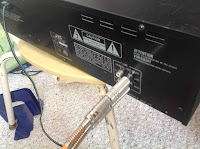Welcome the participants and introduce the leaders
Provide any housekeeping details
Quickly adapt activities to match the age group
Summarize what is about to happen for the next hour. Ask for a show of hands if anyone has made perogys before? Record the number of hands for evaluation purposes.
Carry on with the program:
Define perogy
What is a perogy?
Who invented the perogy?
Any other perogy trivia
Perogy activities in the library
i. Playdough
Demonstrate what a perogy looks like using playdough, remind kids not to eat it. Pinching is the most important part. Good for fine motor skills. Get kids to practice pinching a playdough perogy
ii. Paper
Show paper perogys of different sizes and put out supplies, paper, glue,
sizzors, cotton balls, to make a paper perogy.
iii. Book
Read a book about perogys or kids cooking: suggestions: Two old potatoes and me, talaya in the kitchen, anick and the bannock
iv. Games
Hot perogy. Two kids in the middle, perogy gets passed. One kid says go, the other stop. Their eyes are hid.
Move to the recreation complex for a cooking demonstration
1. As the group leaves, assign someone to count heads
2. Have kids wash their hands
3. Demonstrate how to pinch a real perogy.
4. Now the kids are allowed to make their own perogies
5. Print names on their plates and call the kids up to collect them
6. Give out three premade platkas and balls of filling
7. Kids take their plate to their table to pinch the perogys.
8. Kids line up at the concession counter with their plates.
9. Helpers behind the counter have four boiling pots of water.
10. Boil in separate pots until the perogies float, about 3 minutes
11. Ladle out the perogies with a slotted spoon and add butter.
12. Return them to the proper kid.
13. If you have enough supplies, make more.
14. For gluten free, try this with dumpling rice wrappers
Farewell
Before the kids head out to play, gather them together
• Ask how the day went?
• Would they try to make perogies again one day on their own?
• Record the number of hands for evaluation purposes.
• Remind the kids about next week’s program, send them off
• Clean-up with the volunteers
Hints and suggestions
Gather volunteers early. Remember to give time for grocery shopping. Prep the platkys by making the dough and filling the night before and placing it in the fridge overnight. Place the platkys on towels sprinkled with flour and keep the dough from touching. The dough needs to be soft and sticky. Keep track of volunteer hours for evaluation and reporting.
While the platkys and filling were prepped, Nadia, Sharon’s mother, had brought four small pots of water to boil in the kitchen. So they could sample their own product, the perogies were cooked in separate pots of boiling water in an establishment with a food-handling permit. Through the concession window, each kid was returned a plate of the perogies they had made, to eat.
Tages:
Perogies
Rural Community Librarianship
TD Summer Reading Club
Family literacy
Cultural knowledge
Library programs






